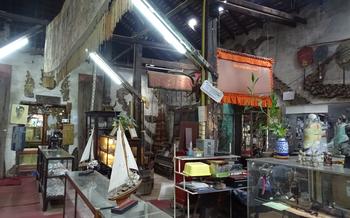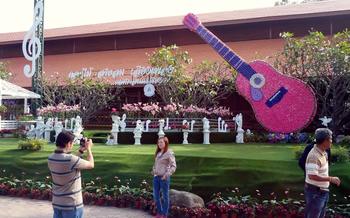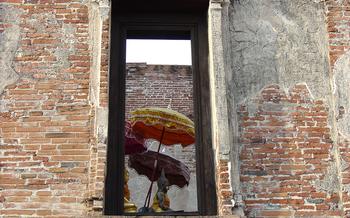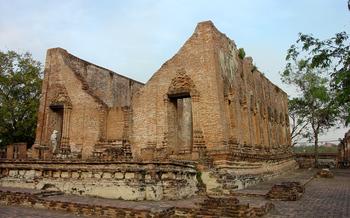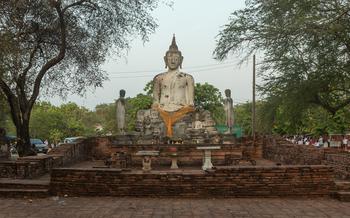
Nang Yai Wat Ban Don Shadow Play Museum
- The Nang Yai Wat Ban Don Shadow Play Museum:
- The Nang Yai Puppets
- The Performance Stage
- The Nang Yai Festival
- Workshops and Classes:
- Souvenirs and Handicrafts
- Photo Opportunities
- Educational Tours
- Cultural Exchange
- Historical Context
- Mythology and Folklore
- Sustainability and Conservation
- Insider Tips for an Enriching Experience
The Nang Yai Wat Ban Don Shadow Play Museum:
Situated in the serene coastal province of Rayong, Thailand, the Nang Yai Wat Ban Don Shadow Play Museum is a treasure trove of cultural heritage and artistic wonders. Dedicated to preserving and showcasing the ancient art of Nang Yai shadow puppetry, the museum offers a captivating glimpse into the rich traditions and folklore of Thailand. Step into this enchanting realm and discover the magic of Nang Yai, where shadows dance and stories come alive.
The museum is conveniently located within the Wat Ban Don temple complex, easily accessible by road. Immerse yourself in the world of Nang Yai as you explore the museum's exhibits, marvel at intricate shadow puppets, and learn about the history and significance of this beloved art form. With its central location and easy accessibility, the Nang Yai Wat Ban Don Shadow Play Museum is a must-visit destination for anyone seeking a deeper understanding of Thai culture and heritage.
Admission to the museum is affordable and offers great value for visitors. The standard ticket price allows you to explore the museum's exhibits at your own pace and admire the stunning collection of Nang Yai puppets. For a more immersive experience, opt for the guided tour, where knowledgeable guides bring the puppets to life, narrating captivating stories and providing insights into the art form's history and significance.
The Nang Yai Puppets
The Nang Yai puppets are not merely decorative figures; they are intricately crafted artworks that embody the essence of the Nang Yai tradition. Traditionally made from cowhide, the process of creating these puppets requires immense skill and dedication. Each puppet is meticulously cut, shaped, and painted by hand, resulting in unique masterpieces that captivate the audience.
The materials used in the construction of the puppets hold cultural significance. Cowhide, a durable and versatile material, symbolizes strength and resilience. The vibrant colors and intricate designs painted on the puppets draw inspiration from Thai mythology and folklore, representing various characters and narratives.
The unique features of the puppets contribute to their captivating presence on stage. Their large size, ranging from 50 centimeters to over a meter, commands attention and allows for expressive movements. The intricate details and embellishments, such as elaborate headdresses and costumes, bring the characters to life, enhancing the visual spectacle of the performance.
Beyond their aesthetic appeal, the Nang Yai puppets serve a profound role in the shadow play performance. Each puppet represents a specific character or entity from Thai mythology or folklore, embodying the stories and narratives that unfold on the stage. The skillful manipulation of the puppets by the puppeteers breathes life into these characters, enabling them to communicate and interact with the audience.
The Performance Stage
The Nang Yai shadow play performances take place on a traditional stage specifically designed to enhance the visual and auditory experience. The stage is typically elevated and surrounded by a dark curtain or backdrop to create a focused and immersive environment for the audience.
The lighting setup plays a crucial role in creating the magical ambiance of the shadow play. Oil lamps or modern spotlights are strategically positioned to cast intricate shadows of the puppets onto the screen, creating a dynamic and captivating visual display.
Sound effects and music are essential elements that accompany the Nang Yai performance. A live ensemble of musicians, often featuring traditional Thai instruments such as the xylophone, drums, and gongs, provides the musical accompaniment. The narrator, known as the "phu khap," uses a unique style of chanting to narrate the story and engage the audience throughout the performance.
The stage setup and lighting techniques work in harmony to create a captivating spectacle that immerses the audience in the world of the Nang Yai shadow play. The combination of visual artistry, music, and storytelling transports viewers to a realm of imagination and cultural heritage.
The Nang Yai Festival
The Nang Yai Festival is an annual celebration that pays homage to the art of Nang Yai shadow play and the legends it brings to life. This vibrant festival is held in Rayong during the month of February, coinciding with the Chinese New Year festivities. The festival is a spectacle of color, music, and tradition, attracting visitors from near and far.
During the Nang Yai Festival, the streets of Rayong come alive with vibrant processions, lively performances, and cultural exhibitions. Shadow play troupes from across the region gather to showcase their skills, captivating audiences with intricate puppetry and enchanting tales. The highlight of the festival is the Nang Yai shadow play competition, where troupes vie for the prestigious title of Nang Yai Master.
To fully immerse yourself in the Nang Yai experience, plan your visit to Rayong during the festival. Witness the magic of Nang Yai shadow play in its full glory, and delve into the rich cultural heritage of Thailand.
Workshops and Classes:
The Nang Yai Wat Ban Don Shadow Play Museum offers workshops and classes for those interested in learning the art of Nang Yai. These workshops are a fantastic opportunity to gain hands-on experience in crafting and manipulating the puppets. Led by skilled artisans, participants will learn about the intricate techniques involved in creating these shadow play masterpieces, from carving and painting the puppets to manipulating them during a performance.
The workshops cover various aspects of the Nang Yai tradition, including puppet-making, storytelling, and performance techniques. Participants will have the chance to create their own Nang Yai puppets, learn about the stories and legends behind the performances, and even try their hand at manipulating the puppets on a shadow play stage. These workshops are not only educational but also a lot of fun, providing a unique and immersive experience into the world of Nang Yai.
The workshops and classes at the Nang Yai Wat Ban Don Shadow Play Museum play a crucial role in preserving and promoting the Nang Yai tradition. By teaching the art to new generations of enthusiasts, the museum ensures that this ancient art form continues to thrive and captivate audiences worldwide.
Souvenirs and Handicrafts
The Nang Yai Wat Ban Don Shadow Play Museum offers a unique opportunity to purchase Nang Yai-themed souvenirs and handicrafts. These items not only serve as mementos of your visit but also contribute to the preservation and promotion of the Nang Yai tradition.
At the museum shop, you can find a variety of souvenirs, including intricate Nang Yai puppets, shadow play masks, traditional musical instruments, and handcrafted textiles. Each item is carefully crafted by local artisans using traditional techniques, ensuring their authenticity and quality.
By purchasing these souvenirs, you not only take home a piece of Thai cultural heritage but also support the local community of artists and craftspeople who keep the Nang Yai tradition alive. Your purchase contributes to their livelihood and encourages them to continue creating these beautiful works of art.
Additionally, the museum hosts regular workshops and classes where visitors can learn the art of Nang Yai puppet making and shadow play performance. These workshops provide an immersive experience and allow you to connect with the local artisans and learn about their skills firsthand.
So, when visiting the Nang Yai Wat Ban Don Shadow Play Museum, don't forget to pick up a souvenir or two. Your purchase will not only enrich your travel memories but also support the preservation and promotion of this unique cultural tradition.
Photo Opportunities
Picture-perfect spots: The Nang Yai Wat Ban Don Shadow Play Museum is a visual treat, offering numerous photo-worthy spots. Capture the intricate details of the Nang Yai puppets, the traditional stage setup, and the colorful backdrop of the museum.
Stunning photographs: To take stunning photographs of the Nang Yai puppets, use natural light whenever possible. Experiment with different angles and perspectives to showcase the puppets' unique features and expressions.
Shareable moments: Share your Nang Yai experience with the world through social media. Use hashtags like #NangYaiMuseum, #ShadowPlay, and #Rayong to connect with fellow travelers and enthusiasts.
Educational Tours
The Nang Yai Wat Ban Don Shadow Play Museum offers educational tours tailored for students, groups, and anyone interested in delving deeper into the world of shadow puppetry. These guided tours provide a comprehensive learning experience that brings the ancient tradition to life.
Knowledgeable guides lead visitors through the museum's exhibits, explaining the history, significance, and techniques of Nang Yai shadow play. Interactive activities and demonstrations engage participants, allowing them to witness firsthand the intricate craftsmanship involved in creating the puppets and the captivating performances that bring them to life.
Through these educational tours, visitors gain a deeper appreciation for the cultural heritage of Thailand and the unique art form of shadow puppetry. They leave with a newfound understanding of the stories, myths, and legends that are woven into the performances, and the importance of preserving and promoting this traditional art form for future generations.
Cultural Exchange
The Nang Yai Wat Ban Don Shadow Play Museum offers a unique opportunity for visitors to engage in cultural exchange and foster cross-cultural understanding. The museum regularly hosts workshops and demonstrations where visitors can learn about the art of Nang Yai shadow puppetry, try their hand at making puppets, and even participate in performances. These interactive experiences provide a platform for visitors to connect with local artists and performers, exchange ideas, and gain insights into Thai culture and traditions.
Moreover, the museum encourages visitors to interact with the local community by organizing cultural events, festivals, and performances. These events not only showcase the beauty and diversity of Nang Yai shadow puppetry but also provide a space for visitors to engage with local artisans, performers, and community members. Through these interactions, visitors can learn about the history, significance, and contemporary practices of Nang Yai, while also contributing to the preservation and promotion of this unique cultural heritage.
Historical Context
Shadow puppetry has a rich and ancient history in Thailand and throughout Southeast Asia, with its roots traced back to the Indian epic tradition of Ramayana. In Thailand, Nang Yai evolved as a unique form of shadow play, blending elements of Thai culture, mythology, and folklore. Over time, the tradition spread to neighboring countries, becoming an integral part of the region's performing arts.
The Nang Yai tradition has undergone several transformations throughout history. Initially, performances were held in temple grounds during religious ceremonies. As its popularity grew, Nang Yai moved to community spaces and dedicated theaters, becoming a form of entertainment for people from all walks of life. The stories and characters depicted in the shadow plays reflected the social, cultural, and political changes that Thailand experienced over the centuries.
Today, Nang Yai remains a beloved and cherished tradition in Rayong and other parts of Thailand. It serves as a living testament to the country's rich cultural heritage, preserving and transmitting stories, legends, and values from generation to generation.
Mythology and Folklore
The Nang Yai shadow play performances are a captivating blend of mythology and folklore, drawing inspiration from ancient Thai legends, epics, and religious narratives. These stories often revolve around the adventures of legendary heroes, mythical creatures, and divine beings, providing insights into the rich tapestry of Thai cultural beliefs and values. Through the shadow play, audiences are transported to enchanted realms, where they witness tales of love, bravery, betrayal, and the eternal struggle between good and evil.
One of the most popular stories depicted in Nang Yai is the epic of Ramayana, which tells the tale of Prince Rama's quest to rescue his beloved wife, Sita, from the clutches of the demon king, Ravana. Other popular stories include the Jataka tales, which recount the previous lives of the Buddha, and local legends that have been passed down through generations.
By delving into the mythology and folklore embedded in the Nang Yai performances, visitors gain a deeper understanding of Thai culture and its rich oral tradition. The shadow play serves as a living testament to the power of storytelling and the enduring legacy of Thailand's cultural heritage.
Sustainability and Conservation
The Nang Yai tradition, like many other forms of traditional art, faces challenges in the modern era. Globalization, changing cultural preferences, and the rise of digital entertainment pose threats to the survival of this ancient art form. Efforts are being made to preserve and protect the Nang Yai tradition, ensuring its legacy continues for generations to come.
The Nang Yai Wat Ban Don Shadow Play Museum plays a crucial role in preserving the art form. The museum houses a collection of Nang Yai puppets, shadow play scripts, and other artifacts that provide valuable insights into the history and evolution of the tradition. By showcasing these cultural treasures, the museum helps raise awareness and appreciation for Nang Yai among visitors.
Another essential aspect of preserving Nang Yai is the involvement of local communities. The museum collaborates with local artisans, puppeteers, and performers to ensure the tradition remains vibrant and relevant. Workshops, classes, and demonstrations are conducted to pass on the skills and knowledge of Nang Yai to younger generations, fostering a sense of cultural continuity.
Sustainable tourism can also contribute to the conservation of Nang Yai. By visiting the museum, attending performances, and purchasing Nang Yai-themed souvenirs, tourists can directly support the local community and help preserve this unique cultural heritage. Responsible tourism practices, such as respecting local customs and traditions, minimizing environmental impact, and supporting local businesses, contribute to the long-term sustainability of the Nang Yai tradition.
Insider Tips for an Enriching Experience
When to Visit: Plan your visit to the museum during the weekdays or early mornings to avoid the crowds and enjoy a more intimate experience.
Photography Etiquette: Remember to ask permission before taking photographs of the performers or the puppets. Be respectful and avoid using flash photography, which can disrupt the performance and damage the delicate puppets.
Local Events and Festivals: Check the local calendar for events and festivals related to Nang Yai and shadow puppetry. These events offer a chance to immerse yourself in the vibrant Thai culture and witness live performances by talented artists.

